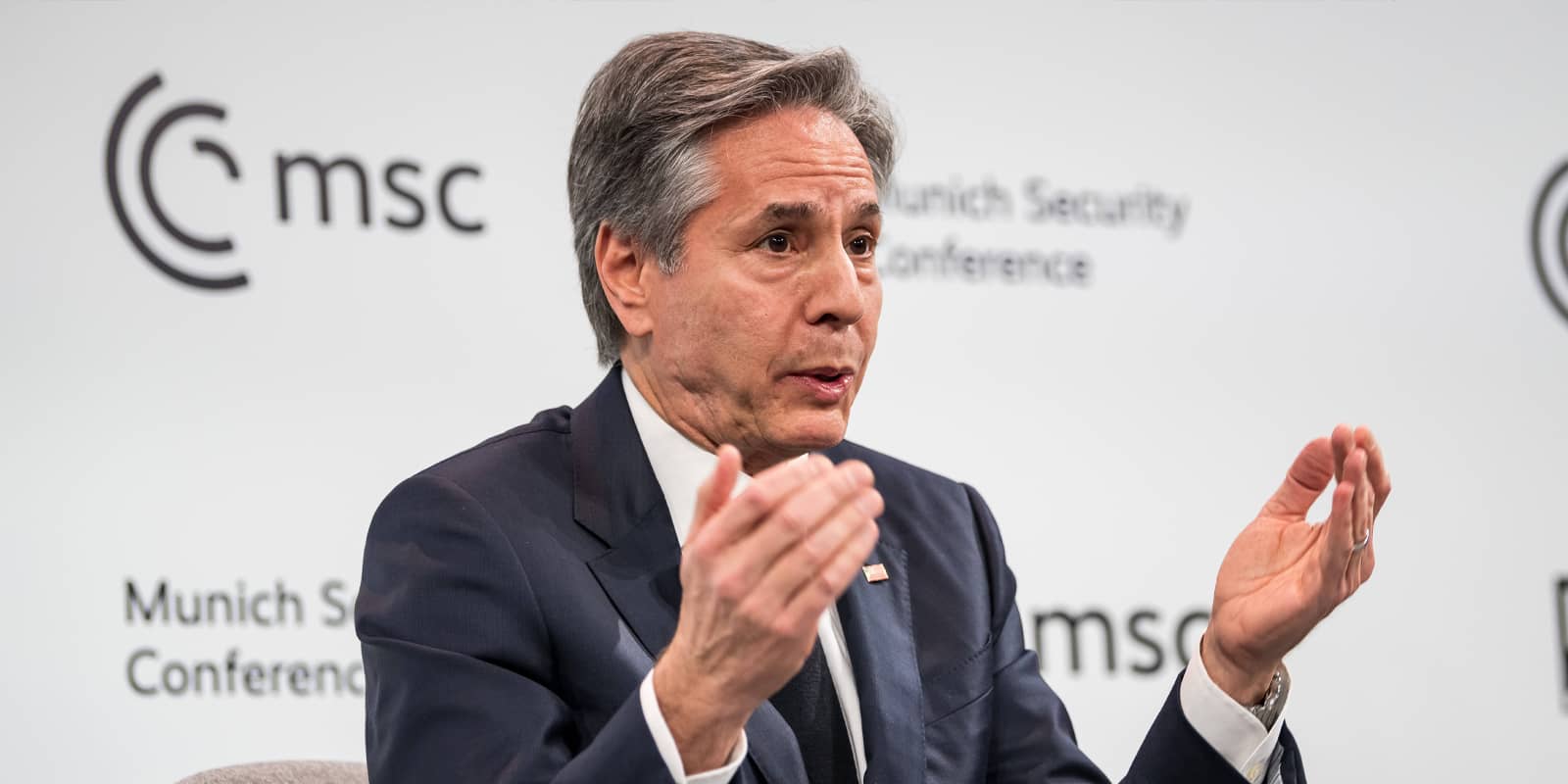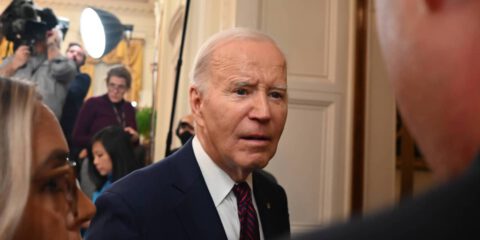Without real action against Iran and its proxies, few if any in the region would feel safe signing on to the well-meant but ultimately delusional designs presented by Secretary of State Blinken in Munich.
Secretary of State Anthony Blinken’s statements in Munich, as well as various leaks and trial balloons launched by American and British officials, indicate the outlines of a “grand package” that the United States and friends plan to offer to all key players in the region: an end to the war, and Hamas rule in Gaza; a path to future Palestinian statehood, with a “revitalized” Palestinian Authority in power in the West Bank and Gaza; Saudi normalization with Israel, followed by other (“almost all”) Arab states, as part of a US-Saudi bargain; a diplomatic solution in Lebanon; and a strong common front against Iran. On the face of it, this would seem to be an attractive proposition to Israelis and stability-seeking Arabs alike. But as the old farmer would have noted, the cart here is hitched ahead of the horse. Unless real action, beyond the present efforts against some of Iran’s proxies, is undertaken to reduce Iran’s power, cut down its proxies, and undo its nuclear ambitions, few if any in the region would feel safe signing on to such well-meant but ultimately delusional designs.
What seems to be on offer?
While the full shape and detail of the plans under discussion in Washington, and with America’s allies and friends in the region, have yet to be determined and presented, several public pronouncements and unofficial messages – including United States Secretary of State Anthony Blinken’s speech at the Munich Security Conference, his British counterpart’s musings about future (conditional?) recognition of a Palestinian state, well-briefed essays by Thomas Friedman, and various other leaks and trial balloons – seem to suggest a grand design standing on six legs:
- An end to the war: presumably, given the Administration’s priorities, with a hostage deal and a long pause in the fighting morphing (somehow) into an arrangement under which Hamas would relinquish its residual military and governmental control, its commanders may be offered to leave the Gaza Strip, and its civic functionarieswould (magically) merge peacefully into an alternative Palestinian model of governance.
- A path to Palestinian Statehood: One such option would involve a promise to offer recognition – i.e., UN Security Council approval of full membership –to be delivered at a future point in time subject to several preconditions and benchmarks: a “revitalized” Palestinian Authority, more responsive and less corrupt, in control of both the West Bank and Gaza; de-radicalization, including a change in education, and an end to incitement and to “pay -for-slay” practices; de-militarization – and hopefully, but perhaps not necessarily (from the present American point of view) the product of a negotiated agreement with Israel.
- Normalization of relations between Israel and Saudi Arabia (and as Blinken has suggested, almost all other Arab countries), in line with ideas that have been pursued before 7 October 2023 and are again under active review – with all that this would presumably entail in terms of Israel finding its place in the region and regaining its economic momentum.
- A parallel US-Saudi deal, involving, among other aspects, formal American security guarantees, as well as US consent to Saudi possession of the nuclear fuel cycle (with all that this may entail in terms of the option to break out –if Iran does so). This would presumably halt Riyadh’s apparent drift toward Beijing.
- A diplomatic deal in Lebanon, along the lines presently pursued by both the US envoy, Amos Hochstein, and the French government – with Hezbollah forces withdrawn north of the Litani river, an enhanced presence by the Lebanese Armed Forces, and a more assertive role for UNIFIL, presumably enabling the internally displaced Israelis to return and rebuild.
- Finally, a stronger front against Iran, in which Israel can play a role alongside its new peace partners, facing the provocations of Iran’s proxies and possibly deterring Tehran from pursuing its regional and nuclear ambitions.
What’s wrong with this picture?
To the untrained eye, this may seem like a proposition that Israel should heartily endorse, resolving some of its most fundamental problems and offering a future of successful integration in the region. Yet even when setting aside the ideological objections to a Palestinian state, and skipping over the leaps of faith and what could be called “magical thinking” about a transformed PA and a Saudi willingness to shake hands openly with Israel’s leadership, there is still a basic flaw in this design which raises serious questions as to its validity.
As already suggested, the cart in this scheme is hitched ahead of the horse: or rather, to use another metaphor, the whole train of consequences is supposed to pull the engine, rather than the other way around. It is the Iranian effort to destabilize the region, reach a commanding position through the use of proxies, and ultimately consolidate a dominant position with a breakout to the bomb, which casts a long and lingering shadow over all prospects for stability, let alone peace, in the region.
Unless a much more robust effort is made to clip Tehran’s wings and cut off its talons, there will be a totalitarian temptation for the Palestinians to latch on to Iran (as they did with Nazi Germany and then with the Soviet Union) rather than accept an American proposition requiring them to accept the legitimacy of Israel and the Jewish people’s right to self-determination. The same will continue to be true for radical players in Lebanon and elsewhere in the region. It was only when Saddam was cut down to size in 1991 that prospects for peace opened up in the region: and the same is true now with the Iranian challenge.
Actions, not words, matter: the present pattern of strikes against the Houthis and against Iranian proxies in Iraq and Syria already had some commendable effects (the Iranians seem to be worried about the possible loss of some of their assets) but are far from enough to force Tehran to change course, let alone abandon its fast-maturing military nuclear project. Much more needs to be done if the true engine of regional transformation – namely, a dramatic reduction in Iran’s capability to do harm – is to tow along other elements of change.
What can Israel do?
So far, reactions in Jerusalem have been focused on the unequivocal and unanimous rejection, in a broader cabinet decision, of the notion of unilateral recognition of a Palestinian State. This is in itself a legitimate position: an externally imposed solution was always a poor and dangerous alternative to a negotiated outcome. Henry Kissinger understood this when he rejected President Richard Nixon’s instruction during the October 1973 War to cut a deal with the Soviets and then dictate it to Israel. So did Egypt’s president Anwar Sadat, when he came to Israel in November 1977 to thwart Jimmy Carter’s idea of cooking up a peace conference together with the Soviets. The dynamics of any attempt to circumvent a negotiated outcome are bound to play into a Palestinian and Arab temptation to demand the impossible (e.g., “the right of return”, etc.) and seek to have it forced upon Israel. This will not work.
Yet more needs to be done beyond protestations of rejection. The logic suggested here – an “Iran (and proxies) first” approach – needs to be systematically imparted to all relevant players in Washington – the Administration, Congress, opinion makers, and last but not least, the key Jewish organizations – as well as to our European interlocutors, and our regional neighbors (whose real preferences, as opposed to what they express in the public domain, are in line with what is suggested here).
Moreover, instead of the Saudi-centered design outlined above – which is unlikely to come to fruition, and in any case offers no practical solution to the actual post-war needs in Gaza – what Israel should do is advance a practical plan of its own for the day after. It is not the intent of the IDF to remain indefinitely in Gaza as the occupying force. Yet Israel is also intent on preventing a return to Hamas rule in Gaza – and convinced, with good reason, that the notion of bringing back a “revitalized” PA is based on a delusion. It is thus necessary to look at other options, including a transitional international presence, which may not offer such a grandiose solution to everything, everywhere, all at once – but can at least deal with the direct challenges ahead.
JISS Policy Papers are published through the generosity of the Greg Rosshandler Family.
Photo: IMAGO / ZUMA Wire / StephanxGorlich/Msc/StephanxGorlx








 - בניית אתרים
- בניית אתרים